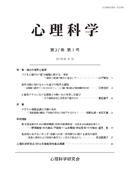Volume 6, Issue 2
Displaying 1-11 of 11 articles from this issue
- |<
- <
- 1
- >
- >|
-
Article type: Cover
1983 Volume 6 Issue 2 Pages Cover1-
Published: March 30, 1983
Released on J-STAGE: September 10, 2017
Download PDF (23K) -
Article type: Cover
1983 Volume 6 Issue 2 Pages Cover2-
Published: March 30, 1983
Released on J-STAGE: September 10, 2017
Download PDF (23K) -
Article type: Appendix
1983 Volume 6 Issue 2 Pages App1-
Published: March 30, 1983
Released on J-STAGE: September 10, 2017
Download PDF (75K) -
Article type: Article
1983 Volume 6 Issue 2 Pages 1-14
Published: March 30, 1983
Released on J-STAGE: September 10, 2017
Download PDF (2052K) -
Article type: Article
1983 Volume 6 Issue 2 Pages 15-30
Published: March 30, 1983
Released on J-STAGE: September 10, 2017
Download PDF (2049K) -
Article type: Article
1983 Volume 6 Issue 2 Pages 31-47
Published: March 30, 1983
Released on J-STAGE: September 10, 2017
Download PDF (2545K) -
Article type: Article
1983 Volume 6 Issue 2 Pages 48-55
Published: March 30, 1983
Released on J-STAGE: September 10, 2017
Download PDF (1119K) -
Article type: Article
1983 Volume 6 Issue 2 Pages 56-68
Published: March 30, 1983
Released on J-STAGE: September 10, 2017
Download PDF (1276K) -
Article type: Appendix
1983 Volume 6 Issue 2 Pages App2-
Published: March 30, 1983
Released on J-STAGE: September 10, 2017
Download PDF (35K) -
Article type: Cover
1983 Volume 6 Issue 2 Pages Cover3-
Published: March 30, 1983
Released on J-STAGE: September 10, 2017
Download PDF (31K) -
Article type: Cover
1983 Volume 6 Issue 2 Pages Cover4-
Published: March 30, 1983
Released on J-STAGE: September 10, 2017
Download PDF (31K)
- |<
- <
- 1
- >
- >|
